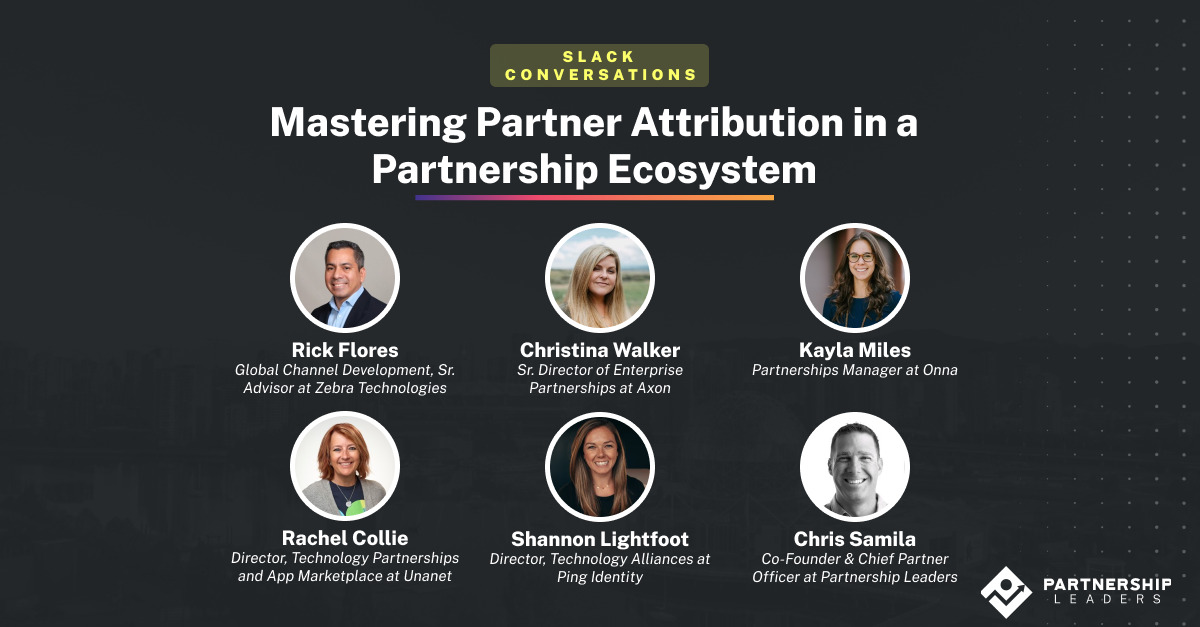Over virtual collaboration spaces, professionals are dealing with a shared challenge – tracking influenced revenue, a crucial part of the partnership ecosystem. This challenge becomes integral for fostering effective collaboration and facilitating growth within the tech industry.
As we explore partner attribution in Salesforce, let’s learn from experienced individuals who offer practical insights.

Among these are Christina Walker, Sr. Director of Enterprise Partnerships at Axon, Rick Flores, Global Channel Development, Sr. Advisor at Zebra Technologies, Rachel Collie, Director, Technology Partnerships and App Marketplace at Unanet, Kayla Miles, Partnerships Manager at Onna, Chris Samila, Co-Founder, Chief Partner Officer at Partnership Leaders, and Shannon Lightfoot, Technology Partnerships at Ping Identity who share their perspectives on tackling the challenges of partner attribution within the partnership ecosystem.
From simplified Salesforce solutions to innovative workarounds and comprehensive objects, these professionals pave the way for efficient and effective tracking of influenced revenue.
Let’s take a closer look at the unique approaches and insights each of them brings to the table.
Partner Origin Tagging in Salesforce
Christina emphasizes simplicity through a user-friendly approach.
“We marked in our SFDC ‘Partner Origin’ and then a drop-down of ‘Pass through’ or ‘Initiated’. Slight learning curve but critical for our stats.” – Christina Walker
They use Salesforce’s ‘Partner Origin’ with clear options like ‘Pass-through’ or ‘Initiated,’ which streamlines the process for their team. This straightforward method ensures a smooth workflow for attributing partner influences, minimizing complexity for efficient tracking and reporting of influenced revenue.
Here’s how it unfolds in their process:
- Initiate with ‘Partner Origin’: The team kickstarts the process by marking in their Salesforce (SFDC) system using the ‘Partner Origin’ as the primary identifier.
- Dropdown Decision-Making: A user-friendly dropdown menu is implemented, offering two clear options – ‘Pass through’ or ‘Initiated.’ This step allows for easy and precise categorization of partner influences.
- Critical Statistics Tracking: Despite a slight learning curve, the team recognizes this method’s vital role in their statistical tracking. The clarity brought by these defined options is worth the initial learning curve.
- Efficiency in Workflow: The straightforward approach ensures a smooth workflow, minimizing complexities attributed to partner influences. This efficiency is crucial for accurate tracking and reporting of influenced revenue.
Partner-Centric Approach with PRM Integration
“We put it on the Partner side. The partner is responsible for flagging it up front in the PRM, which then passes to our CRM.” – Rick Flores.
Rick suggests a partner-centric approach. They let partners flag it in their Partner Relationship Management (PRM), ensuring seamless integration with the CRM. Plus, partners get a sweet incentive for their efforts.
This would help establish a streamlined and collaborative process for partner engagement. By placing the responsibility on the Partner side, partners become active participants in the attribution process.
Flagging it up front in the Partner Relationship Management (PRM) ensures accuracy and facilitates a seamless integration with the Customer Relationship Management (CRM) system. That said, the added incentive for partners further motivates them to proactively contribute to the attribution process, fostering a mutually beneficial and efficient partnership ecosystem.
“For companies with a PRM, tracking attribution is much easier,” Rachel said.
On the other hand, Rachel acknowledges the PRM advantage. Without one, she’s exploring alternative tagging methods. It’s the reality check some companies face, and simplicity becomes vital.
As noted by Rachel, tracking attribution swiftly becomes a straightforward task for companies equipped with Partner Relationship Management (PRM). A PRM offers a centralized hub for managing partner-related activities and interactions within the partnership ecosystem. With dedicated tools and features tailored for partner collaboration, the attribution process is seamlessly integrated into the broader partnership workflow.
The structured nature of a PRM simplifies the tracking of attribution, providing a precise and efficient method for companies to navigate and manage their partner engagements.
Partner Involvement Record for the PRM-less
We create a Partner Involvement Record tied to the SFDC opportunity. Sales team takes <2min to complete the fields on the Record.” – Kayla Miles.
Kayla shares a nifty workaround for those without a PRM. They built a Partner Involvement Record linked to the opportunity in Salesforce. It’s quick, efficient, and doesn’t burden the sales team.
This Partner Involvement Record is a practical solution for companies operating without a Partner Relationship Management (PRM). Kayla highlights its effectiveness by linking it directly to the Salesforce (SFDC) opportunity.
This clever workaround ensures a swift and efficient process, with the sales team investing less than two minutes to complete the required fields on the Record. This simplifies the attribution process and minimizes any potential burden on the sales team, allowing for a seamless integration of partner involvement within the partnership ecosystem.
Opportunity Partner Role Object in Salesforce
“We have an object called Opportunity Partner Role used by all Partner teams. This is how we attribute influencing and sourcing to the partner account for reporting.” – Shannon Lightfoot.
Shannon introduces a robust system leveraging the ‘Opportunity Partner Role’ object within Salesforce. This object is a central element for all Partner teams, streamlining the attribution of influence and sourcing back to the partner account for comprehensive reporting.
By incorporating the ‘Opportunity Partner Role’ object, businesses can establish a cohesive and efficient approach to managing partner engagements within the partnership ecosystem.
Conclusion
Partner attribution doesn’t have to be a headache. Diverse and practical approaches are available for companies to navigate the challenges within the partnership ecosystem. Each method ultimately comes with unique advantages.
Join The 1850+ Leaders Transforming Partnerships
As a member of Partnership Leaders you will:
- Build and learn with the top partner people at the best companies around the world.
- Increase your impact and accelerate your career with proven resources, tools, and best practices.
- Grow a network of peers, partners, and advisors with common objectives.


